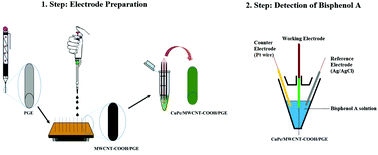A novel copper(ıı) phthalocyanine-modified multiwalled carbon nanotube-based electrode for sensitive electrochemical detection of bisphenol A†
Abstract
A novel copper(II) phthalocyanine (CuPc)-modified multiwalled carbon nanotube-based electrode was prepared for the sensitive electrochemical detection of bisphenol A, by the modification of a pencil graphite electrode via the adsorption method. The synthesized novel CuPc was characterized by spectroscopic methods and the electrodes were characterized by electrochemical, spectroscopic and microscopic methods. The limit of detection (LOD, S/N = 3) was calculated as 0.0189 μM for bisphenol A. The experimental parameters such as pH and adsorption time were optimized for the electrochemical detection of bisphenol A. The detection was done in real samples, with a high recovery value (>98%), indicating the useful application of modified electrodes as electrochemical sensors for bisphenol A. The electrodes showed excellent repeatability and stability in the differential pulse voltammetric detection of bisphenol A. The prepared novel sensor can be used for the detection of bisphenol A in many environmental analyses due to its simplicity, low cost, environmental friendliness and high sensitivity.



 Please wait while we load your content...
Please wait while we load your content...